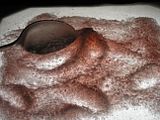These are the correct ratios:
Narrowing down a name for this compound is rather tricky. In the literature is is commonly referred to as acetone peroxide because it is typically a mixture of isomers. Other literature refers to it as tricycloacetoneperoxide, triacetonetriperoxide, TATP, AP, TCAP, and 3,3,6,6,9,9-hexamethyl-1,2,4,5,7,8-hexoxonane. Many types of chemicals react with air and light to form explosive peroxides, usually this is a bad thing because their formation occurs without intent. A compound being distilled in the lab may explode if peroxides have formed, this is why a small amount of liquid is always left undistilled.
This particular formula is intriguing because of its simplicity to make and the availability of the chemicals used. This simplicity has made it very popular among fools. Instruction derived from the Big Book of Mischief, and their loathsome breed, are lacking in detailed information that may determine a continued success or failure at this procedure. An abundance of misinformation has led to much confusion about acetone peroxide. The information presented here is directly from the original scientific references by the scientists who developed this explosive, not some "crap book" as listed above. There are actually two isomers of acetone peroxide, the first is tricycloacetone peroxide, which is what will be made here, and the second is dicycloacetone peroxide. Both of these compounds are very similar, but the reaction seems to favor the tricyclo over the dicyclo at lower temperatures. The tricyclo isomer is more stable and more powerful than the dicyclo, that is why every effort is made to prepare the former. Both isomers will be made in the reaction with the tricyclo being the principal product. There are also a varity of other peroxides made in this synthesis; see the reaction scheme below.
Acetone peroxide would have made a decent military explosive if not for its instability. It can not be stressed enough how unstable and dangerous acetone peroxide is. As instability goes this is among the most unstable of other explosives here.
Acetone peroxide is formed by acid-catalyzed nucleophilic addition. That means an acid helps the peroxide, a nucleophile, react with the acetone, a ketone. A nucleophile is a "nucleus lover," or a chemical species that donates electrons. A ketone is a substance that has the molecular formula R2C=O where R is any carbon chain. There is some confusion as to which acid to use, the useless internet books frequently cite hydrochloric acid as the acid to use. The fact is, the acid is only a catalyst, it does not matter what acid is used, as long as it is a strong acid. Only inorganic acids fit this criteria. Since the original literature uses sulfuric acid, this lab uses sulfuric. You may use whichever acid is the most economical, or available.
Acetone, hydrogen peroxide, and sulfuric acid, the chemicals used in this lab, are all available over the counter. That is the real reason this explosive is so popular, it is unfortunate that this explosive is so dangerous. Since 30% hydrogen peroxide is hard to obtain, substituting 10 times the volume of commercially available 3% peroxide is acceptable, although this will lower the yield a bit. It is also advisable to multiply the volume of acid by a corresponding value.
Ketone peroxide reaction scheme:
CHEMICALS APPARATUS
acetone 500-mL beaker
ethyl ether eye dropper
hydrogen peroxide graduated cylinder
sulfuric acid separatory funnel
distilled water stirring rod/stirrer
thermometer
To a 500-mL beaker add 50 mL of acetone, then stir in 30 mL of 30% hydrogen peroxide. Place the beaker in a salt-ice bath and cool it to 5° C. After cooling, slowly add 3 mL of 75% sulfuric acid drop by drop with an eye dropper. Stir the mixture continuously while adding the acid, keep the temperature between 5° C to 10° C, stop adding acid if the temperature gets to high. It is very important that you moderate the reaction, high temperatures will lower your yield and cause the formation of the less useful dicyclo isomer. After adding all the acid, continue stirring for 5 minutes. Keep the mixture in the bath for 1 to 3 hours, or even up to 24 hours. After sitting, a white precipitate should have formed. Filter the mixture to collect the crystals, then wash them with 300-500 mL of water. Allow the crystals to dry before using, keep them damp if storing. For increased purity, add the precipitate to ethyl ether and let it dissolve. Place the ethyl ether solution in a separatory funnel and wash by shaking with three portions of cold water. Add the ethyl ether solution to a beaker and heat it on a steam bath to evaporate the ethyl ether. It should take about 3 hours to dry. You will need a graduated cylinder for measuring liquids, a stirring rod or magnetic stirrer for mixing, and a thermometer to monitor the temperature.
I would suggest making this explosive shortly before it is desired to use it as it is never wise to keep unstable primary explosives around too long. It can be stored rather safely under water for some time. If allowed to stand in the open it will vaporize after some weeks. If stored in a sealed container it may crystallize into the crevaces of the cap which could detonate from the friction of opening. Mixing with RDX, PETN, or picric acid will improve the stability of this explosive.
THIS IS ACTUALLY A SLIGHTLY CONTAMINATED BATCH, DUE TO A THERMOMETER BREAKING AS I WAS DISLODGING A CHUNK OF AP.
